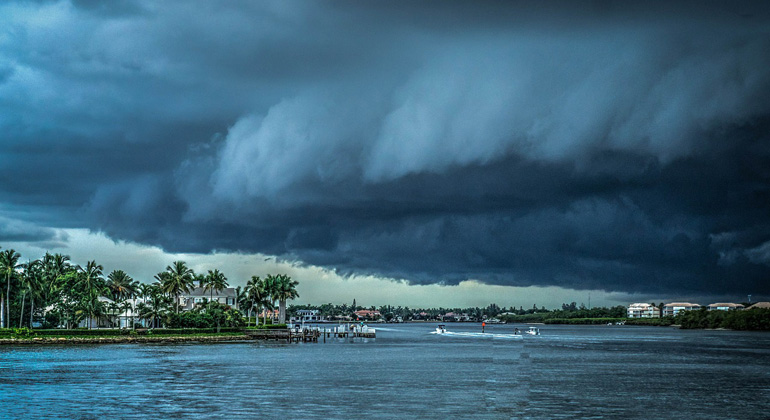Global South most affected by climate change and land use effects
Where people’s needs for nature are greatest, nature’s ability to meet those needs is declining.
By 2050, up to 5 billion people could be at higher risk of water pollution, coastal storms or under-pollinated crops with a majority living in developing countries. This is one of the most alarming results of a study recently published in Science by an international research team with contribution of the German Centre of Integrative Biodiversity Research (iDiv) and the Martin Luther University Halle-Wittenberg (MLU). The team produced a high-resolution global map showing the distribution of nature’s ability to provide services to humankind. These services are increasingly threatened by human-driven degradation of ecosystems and biodiversity. The map may improve policy and decision-making around investments in nature locally as well as globally. With the help of sustainable development, the threats to vital ecosystem services may be reduced.
Nature supports people in critical ways, often at a highly local level. A wild bee buzzes through a farm, pollinating vegetables as it goes. Nearby, wetlands remove chemicals from the farm’s runoff, protecting a community drinking water source. In communities all around the world, nature’s contributions are constantly flowing to people. A new study with contribution of the German Centre for Integrative Biodiversity Research (iDiv) and the Martin Luther University Halle-Wittenberg (MLU), published in Science, uses high-resolution satellite data to funnel the details of individual local analyses into one, global map. Using advanced technology and software, the researchers created interactive maps that showcase the details of local analyses on a global stage. Informed by this planet-wide analysis, the paper emphasizes nature’s declining ability to protect people from water pollution, coastal storms and under-pollinated crops.
“For the first time, we have mapped globally the overlap between the provision of ecosystem services and the areas where people are most dependent on nature to meet their needs,” said co-author Prof Henrique Miguel Pereira, head of the Biodiversity Conservation working group at iDiv and MLU. “We find that ecosystems are being degraded in places where people are particularly dependent on nature. This is very worrying and requires policies to immediately stop the degradation of ecosystems”
The researchers focused on three fundamental benefits that nature provides to people: water quality regulation, protection from coastal hazards and crop pollination. Using open-source software developed by the Natural Capital Project, they modeled how the flow of these benefits might change in the future.
5 billion could be at higher risk
Across the board, they found that where people’s needs for nature are greatest, nature’s ability to meet those needs is declining. By 2050, their projections show that up to 5 billion people could be at higher risk of water pollution, coastal storms and under-pollinated crops.
Critically, the team’s research shows that these impacts are inequitably distributed. In all scenarios, developing countries shoulder a disproportionate share of the burden. People in Africa and South Asia are the most disadvantaged in the face of diminishing contributions from nature. More than half the population in these regions is facing higher-than-average “benefit gaps,” the tangible elements — like vulnerability to coastal storms, water pollution or crop losses — that people feel when contributions from nature stop flowing. The impacts aren’t isolated to certain countries, though. Under climate change, projected sea-level rise increases risk to coastal communities everywhere and may impact over 500 million people worldwide by 2050.
Informing policies to invest in nature
In an increasingly globalized world, this new technological application of integrated, high-resolution data provides an opportunity to incorporate nature into worldwide policy decisions. With accessibility in mind, a key priority of the research was to produce high-resolution, interactive maps through an online viewer. Not only did this viewer help the team digest the data internally, but it now serves as a model for presenting complex global data to key decision-makers in a digestible way.
The goal of this research — and future projects building off this new approach — is to help inform policy and decision-making around investments in nature. For example, the models suggest that places within the Ganges Basin and parts of Eastern China can be targeted for high-impact investments in natural ecosystems. Preserving or restoring these areas’ ecosystems will help bolster the wellbeing of entire communities.
The team is looking to policymakers, development banks and other global influencers to use this information to drive sustainable development and conservation. Looking forward, the researchers are expanding their analysis to model other ecosystem benefits. They’re also looking to more deeply understand where nature’s contributions could best support the planet’s most vulnerable populations. “We’re equipped with the information we need to avert the worst scenarios our models projected and move toward an equitable, sustainable future,” said Dr Becky Chaplin-Kramer, lead scientist at Stanford’s Natural Capital Project and lead author on the study. “Now is the time to wield it.”
Source
German Centre for Integrative Biodiversity Research (iDiv) Halle-Jena-Leipzig 2019








